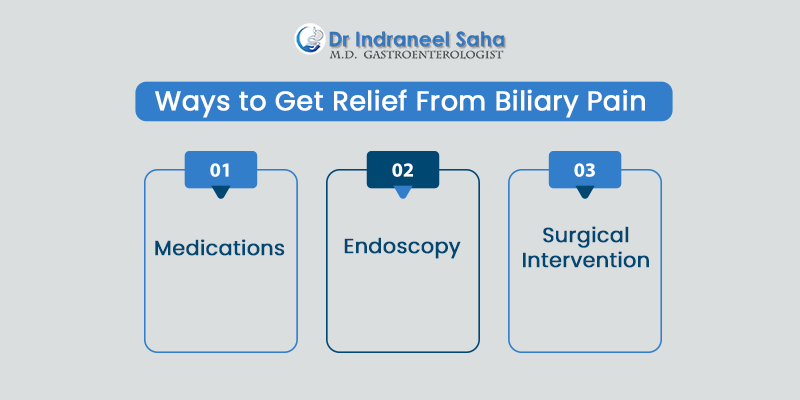- 22nd Oct, 2024
- ERCP Stone Extraction
Ways To Manage Pain Related To Bile Duct Obstruction
Bile duct blockages caused by conditions such as choledocholithiasis, cholangitis and biliary strictures are known to cause pain, inflammation, infections and other symptoms such as chills, jaundice and fever. These disorders obstruct the bile ducts which carry the bile (a digestive fluid that breaks down fats) and disrupt its flow from the liver into the intestine through the gallbladder. As a result, the bile remains in the liver, leading to complications that need proper management.
There are several effective strategies to get relief from the pain and discomfort related to bile duct conditions and enhance the quality of life of those affected. In this blog, we will discuss the nature of the pain and the various approaches to managing it.
How Does Biliary Pain Feel Like?
Biliary pain, also known as biliary colic, is usually felt in the upper right abdomen but often radiates back to the back and right shoulder. You feel like a sudden, severe, or cramping ache that can be very intense.
Patients are likely to experience biliary discomfort all of the sudden; however, it mainly occurs after eating a large meal because it causes contractions in the gallbladder. The ache can last for 15–30 minutes, but in severe cases, the attacks can continue up to a few hours.
At times, the pain is accompanied by nausea and vomiting, sweating and abdominal tenderness.
Ways To Get Relief From Biliary Pain
Pain emerging from bile duct obstructions can be managed in the following ways:
- Endoscopy: Procedure like ERCP stone extraction is the most effective in treating biliary tract disorders. ERCP stands for Endoscopic Retrograde Cholangiopancreatography. It is a technique where your doctor will insert a long flexible tube called the endoscope and a special dye to see the internal organs and remove stones or tumours from the bile ducts.
- Surgical intervention: In some cases, surgical interventions are required to treat the blockages, for instance, if the pain is caused by recurrent gallstones.
- Medications: To give temporary relief, your doctor might also prescribe you over-the-counter medications to manage mild to moderate pain. However, prolonged use of these medications has side effects.

When Should I Seek Medical Help For Biliary Obstructions?
The intensity and type of symptoms for biliary obstructions depend upon its cause. Below are the warning signs indicating that there is a high chance of blockages in the bile ducts.
- Pain in the upper right abdomen
- Jaundice
- Clay-coloured stools
- Dark urine
- Nausea and vomitting
- Sudden weight loss
- Extreme tiredness
- Sudden weight loss
- Loss of appetite
Alternative Remedies To Manage Biliary Discomfort
Besides ERCP stone extraction or surgical intervention, below are the following remedies that provide immediate relief to biliary pain.
- Dietary changes: Eliminate fried, greasy, and oily foods; instead, include non-saturated fats and use vegetable oil for cooking.
- Warm compress: Applying heat over the affected area provide relief from the pain and discomfort. You can place a warm wet towel or a heating pad. Repeat the process until the pain subsides.
- Acupuncture: It is another substitute to manage the episodic attacks of severe pain in the abdomen ache, stomach pain and nausea.
- Yoga: Though there is no scientific evidence, engaging in exercise and yoga can help with the pain related symptoms of biliary obstructions.
Wrapping up
Remember that the above alternative solutions do not guarantee results. It is always advisable to consult a gastroenterologist and discuss your concerns.
If you want to seek permanent treatment, contact Dr. Indraneel Saha, who has more than three decades of experience in diagnosing various GI ailments with exemplary procedures like ERCP stone extractions, polypectomy, liver biopsy and more.